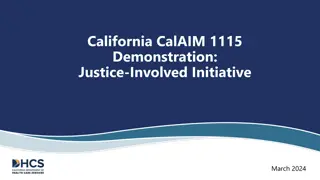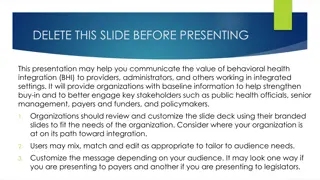Transforming California's Behavioral Health Care System for Comprehensive Support
California's Health and Human Services Agency is dedicated to transforming the behavioral health care system to ensure all Californians have access to high-quality care. This transformative effort includes addressing capacity challenges, enhancing crisis services, providing more community-based options, and advancing equity. Various initiatives and programs are being implemented to modernize and improve the state's behavioral health system, catering to the needs of children, youth, and individuals with mental health or substance use disorders.
Download Presentation

Please find below an Image/Link to download the presentation.
The content on the website is provided AS IS for your information and personal use only. It may not be sold, licensed, or shared on other websites without obtaining consent from the author. Download presentation by click this link. If you encounter any issues during the download, it is possible that the publisher has removed the file from their server.
E N D
Presentation Transcript
CSAC Health and Human Services Policy Committee Meeting Stephanie Welch, Deputy Secretary of Behavioral Health, MSW California Health & Human Services Agency Person Centered. Equity Focused. Data Driven. Healthy Healthy
Systemic Change to Behavioral Health Care This Administration, similar to the leadership demonstrated in the Legislature, is deeply committed to transforming the Behavioral Health Care System. Transforming the behavioral health system will ultimately create generational change so ALL Californians have access to high quality, culturally responsive and easily accessible behavioral health care. Criticalinvestment is needed to build new behavioral health capacity and reduce fragmentation in the behavioral health system - both for mental health and substance use disorders. Much of this is driven by decades of stigma, where behavioral health was not considered a core component of the health system. 2
Systemic Change to Behavioral Health Care Behavioral Health Assessment confirmed that there are capacity challenges across the continuum. The report calls out the NEED for A comprehensive approach to crisis services More community-based living options, from housing to long-term residential, for people living with serious mental illness and/or a substance use disorder More treatment options for children and youth with significant needs as well as efforts to prevent behavioral health conditions Services and strategies that advance equity and address disparities Addressing related housing, economic and physical health issues especially for individuals who are justice-involved Assessing the Continuum of Care for Behavioral Health Services in California Data, Stakeholder Perspectives, and Implications 3
Systemic Change to Behavioral Health Care California Advancing and Innovating Medi-Cal (CalAIM) which modernizes, improves, and simplifies Medi-Cal s BH system and the CalAIM Justice Package The Children and Youth Behavioral Health Initiative (CYBHI) provides $4.4B (including support for the MHSOAC Student Mental Health Initiative) to reimagine behavioral health system for children and youth The Behavioral Health Continuum Infrastructure Program (BHCIP) and the Community Care Expansion (CCE) Programprovide$3B to build out community based care, including residential placements New Peer Support Services Benefit in Medi-Cal (Launch July 2022) Department of Managed Health Care Mental Health Parity Enforcement and Behavioral Health Focused Investigations Efforts 4
Systemic Change to Behavioral Health Care Established an Office of Suicide Prevention CalHHS conducting comprehensive Crisis Care Continuum Planning CalHOPE a crisis counseling assistance and training program, prepping for 9-8-8 implementation California Medicated Assisted Treatment (MAT) Expansion Project, pilot Contingency Management in outpatient treatment settings Address the Incompetent to Stand Trial population including expansion of the Department of State Hospitals Diversion and Community-Based Restoration Program 5
2022-2023 Proposed Budget Priorities CalHHS and its departments have identified the following priorities for this year s budget: Improve the state s ability to serve the whole person, and advance the goal that health care, housing, and social needs are considered together, rather than through the lens of separate funding streams or programs. We must double down on addressing the needs of those with serious mental illness, those who are justice-involved, as well as immigrants, children, and aging populations, to improve the lives of California s most vulnerable residents while addressing underlying inequities in society. 6
Systemic Change to Behavioral Health Care Proposed 2022-23 Budget Builds on Existing Efforts: Medi-Cal Community-Based Mobile Crisis Services $108M ($16M GF) DHCS will add multi-disciplinary mobile response services for crises related to mental health and substance use disorders as a new Medi-Cal benefit, as soon as January 1, 2023. CalAIM and Providing Access and Transforming Health (PATH) - $1.3B over five years to support the development of Enhanced Care Management and Community Supports in CalAIM. $561M over five years to support implementation of CalAIM justice-involved initiatives. Expanding Access to MAT - $96M GF in 2022-23 and $61M ongoing $86M Opioid Settlement funds for a youth opioids education and awareness and fentanyl risk education($50M), improving the state s ability to collect and analyze data on opioid overdose trends ($5M), provider training on opioid treatment ($26M), and distributing naloxone to homeless service providers ($5M) 7
Workforce for a Healthy California for ALL Care Economy Workforce Development - $1.7B investment for the Labor and Workforce Development Agency and CalHHS to create innovative and accessible opportunities to recruit, train, hire, and advance an ethnically and culturally inclusive health and human services workforce, with improved diversity, compensation, and health-equity outcomes. California 25x25 Initiative $350M to recruit, train, and certify 25,000 new community health workers California Social Work 2030 Initiative $210M Psychiatric Resident Program $120M Multilingual Health Initiatives $60M to expand scholarships and loan repayment programs in healthcare and social work for multilingual applicants, with the goal of increasing language and cultural competencies throughout the care workforce. 8
Systemic Change to Behavioral Health Care Proposed 2022-23 Budget Builds on Existing Efforts: Behavioral Health Bridge Housing - $1.5B to address the immediate housing and treatment needs of people experiencing or at eminent risk of homelessness with serious behavioral health conditions, funding can be used to purchase and install tiny homes and to provide time-limited operational supports in these tiny homes or in other bridge housing settings including existing assisted living settings. Solutions to Address the Incompetent to Stand Trial (IST) Crisis - $571M to provide immediate solutions to support access to treatment for the roughly 1800 individuals currently found IST on felony charges and waiting in jail and to expand Diversion and Community-Based Restoration Capacity to increase IST community based treatment alternatives. 9
Community Assisted Empowerment and Recovery (CARE) Court CARE is a new approach and a paradigm shift. CARE aims to deliver behavioral health services to the most severely ill and vulnerable individuals, while preserving self-determination and community living. CARE is an upstream diversion to prevent more restrictive conservatorships or incarceration. CARE is based on evidence which demonstrates that many people can stabilize, begin healing, and exit homelessness in less restrictive, community-based care settings. CARE seeks both participant and system success. 10
Community Assisted Empowerment and Recovery (CARE) Court Care is fundamentally different from Mental Health/ LPS Conservatorship in that it does not include custodial settings or long-term involuntary medications CARE is different than LPS/Laura s Law in several important ways: May be initiated by a petition to the Court from a variety of people known to the participant (family, clinicians/ physicians, first responders, etc.) and only credible petitions are pursued Multiple negative outcomes (incarceration, hospitalizations, etc.) are not required to be considered Local government and participants work together and are both held to the CARE plan Provides a Supporter trained to assist in identifying, voicing, and centering the individual s care decisions in their CARE plan and graduation plan, including preparing a Psychiatric Advanced Directive, if desired. 11
CARE Court Pathway CLINICAL EVALUATION SUPPORT CARE PLAN SUCCESS Petition 12
Why Doesnt CARE Include All Behavioral Health Conditions? CARE is for people with a focused diagnosis that is both severely impairing and also highly responsive to treatment, including stabilizing medications. Broader behavioral health redesign is being led by the Administration through to create generational change so all Californians have access to high quality, culturally responsive and easily accessible behavioral health care. Critical investments include building new behavioral health capacity through treatment and workforce infrastructure and reducing fragmentation in the behavioral health system--both for mental health and substance use disorders. 13
Does CARE Guarantee Housing? Housing is an important component of CARE finding stability and staying connected to treatment, even with the proper supports, is next to impossible while living outdoors, in a tent or a vehicle. Care Plans will include a housing plan. Individuals who are served by CARE Court will have diverse housing needs on a continuum ranging from clinically enhanced interim or bridge housing, licensed adult and senior care settings, supportive housing, or housing with family and friends. Governor's proposed 2022-2023 budget includes $1.5 billion for Behavioral Health Bridge Housing, which will fund clinically enhanced bridge housing settings that are well suited to serve CARE Court participants. 2021 Budget Act made a historic $12 billion investment to prevent and end homelessness. 14
Does CARE Assist with Implementing SB 317? If the Court finds the defendant ineligible for diversion it can refer the defendant to the CARE program. A hearing to determine eligibility for CARE shall beheld within 14 days after the date of the referral. If the hearing is delayed beyond 14 days, the court shall order the defendant, if confined in county jail, to be released on their own recognizance pending that hearing. If the defendant successfully completes CARE, the charges shall be dismissed. 15
What if an Individual does not Participate in Court ordered Care Plan? If the Court determines at any time during the proceeding that the participant is not participating in CARE proceedings, the Court may terminate the respondents participation in the CARE program. The Court may utilize existing authority to ensure an individual s safety. Subsequent proceedings may use the CARE proceedings as a factual presumption that no suitable community alternatives are available to treat the individual. 16
On the Horizon - SMI/SED IMD Wavier CMS permits states to use 1115 demonstrations to receive FFP for care provided to Medicaid members living with SMI/SED in qualifying institutions for mental disease (IMDs), provided states establish a robust continuum of community-based care and enhance oversight of inpatient and residential treatment settings. California committed to pursuing the SMI/SED demonstration in the January 2021 revised CalAIM proposal. California was the first state to obtain a similar waiver allowing IMD expenditure authority for SUD IMDs in exchange for strengthening SUD services under the Drug Medi-Cal Organized Delivery System (DMC-ODS). DHCS intends to use this experience to design and implement the SMI/SED demonstration. In October of 2021, CMS provided guidance to secure FFP for longer stays in Short Term Residential Therapeutic Programs (STRTPs) classified as IMDs for youth in the child welfare system for a period of up to two years. States must submit a detailed plan with key milestones and timeframes for transitioning children out of STRTPs that are IMDs. 17
Behavioral Health Coordination Efforts CalHHS: Facilitating cross departmental and cross agency meetings on topics such as infrastructure, workforce, homelessness, children and youth and advancing equity all with an eye to coordinate initiatives and conduct real time problem-solving and share lessons learned. Leading cross departmental and cross agency coordination of the CYBHI, ensuring youth driven and family focused approaches to planning and stakeholder engagement as well as system design and evaluation. 10 of CalHHS departments and 2 offices participate in the Behavioral Health Taskforce which is re-launching with structured meetings and workgroups to facilitate information sharing and collaboration. 18
Questions and Discussion Resources CARE Court - California Health and Human Services Behavioral Health Task Force - California Health and Human Services Children and Youth Behavioral Health Initiative - California Health and Human Services Office of Youth and Community Restoration (OYCR) - California Health and Human Services New CalAIM webpage: https://www.dhcs.ca.gov/calaim Stephanie.welch@chhs.ca.gov (916) 549-5048 (cell/text) 19























